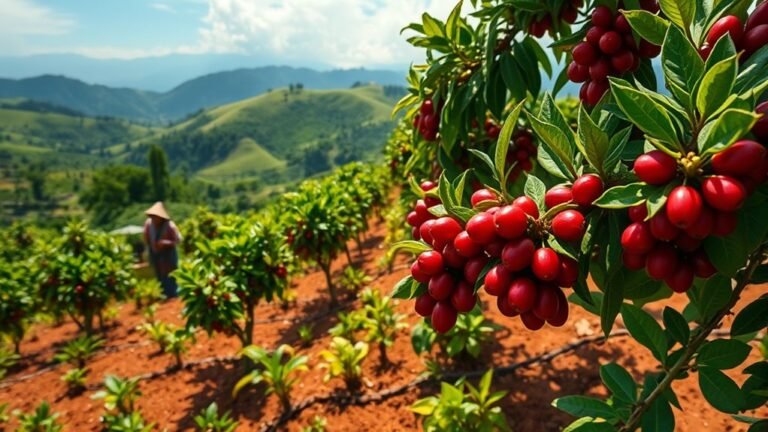Why Is My Coffee Sour? (And How to Fix It)
Your coffee tastes sour because key variables like grind size, water temperature, or brewing time are off, causing under-extraction that emphasizes acidic compounds. A coarse grind, low water temperature (below 195°F), or too short a brew lets sharp acids dominate. To fix this, use a medium-fine grind, maintain water between 195°F-205°F, and adjust brewing time to guarantee full extraction. Fine-tuning these factors brings balance and reduces sourness—there’s more to explore on mastering this craft.
Understanding the Sour Taste in Coffee

Although coffee’s acidity is a natural and desirable characteristic, the sour taste you experience usually results from specific factors such as under-extraction, improper grind size, or incorrect brewing temperature. Coffee acidity contributes to brightness and complexity, but when unbalanced, it shifts toward unpleasant sourness. If your grind is too coarse, water flows too quickly, extracting insufficient solubles and emphasizing acidic notes. Conversely, water that’s too cool won’t adequately dissolve flavor compounds, leaving the brew sharp and underdeveloped. Attaining proper flavor balance means adjusting grind size finer and maintaining ideal brewing temperatures between 195°F and 205°F. By controlling these variables, you guarantee a harmonious extraction where acidity enhances rather than dominates, granting you the freedom to enjoy coffee’s nuanced profile without unwanted sourness.
The Role of Coffee Bean Origin and Roast Level
You’ll notice that coffee bean origin greatly influences acidity levels, with beans from regions like East Africa often exhibiting brighter, tangier profiles. The roast level further affects sourness; lighter roasts retain more of these acidic compounds, while darker roasts reduce them by breaking down organic acids. Understanding how origin and roast interact helps you adjust your brew to balance or minimize sour notes effectively.
Impact of Bean Origin
Two key factors determine the acidity and sourness in your coffee: the origin of the beans and their roast level. Focusing on bean origin, you’ll find that bean characteristics vary widely based on growing conditions—altitude, soil, and climate all shape flavor profiles. For example, beans from East Africa often possess bright, citrusy acidity, which can present as sourness if you’re not accustomed to it. Conversely, beans from Brazil tend to have lower acidity with nuttier, chocolatey notes. Understanding these origin-based traits helps you select beans aligned with your taste preferences, giving you the freedom to avoid unwanted sourness. When you choose beans, consider how their natural acidity and flavor profiles will interact with your brewing method to create the balance you want.
Roast Level Effects
Beyond bean origin, roast level plays a significant role in shaping your coffee’s acidity and sourness. Light roasts retain more organic acids, leading to pronounced fruity, tangy notes that can border on sour if brewed improperly. Dark roasts, conversely, undergo Maillard reactions that reduce acidity, creating a smoother, less sour profile. Understanding these effects lets you tailor your roast choice to your taste and brewing method.
| Roast Level | Acidity Profile |
|---|---|
| Light Roasts | High acidity, bright |
| Medium Roasts | Balanced acidity |
| Dark Roasts | Low acidity, mellow |
| Over-Roasted | Bitter, flat acidity |
Adjust grind size, water temperature, or brew time to mitigate unwanted sourness tied to roast level.
How Grind Size Affects Coffee Flavor
Although grind size might seem like a minor detail, it plays an essential role in determining the extraction rate and ultimately the flavor profile of your coffee. The particle size directly affects how water interacts with coffee grounds—too coarse, and water flows too quickly, under-extracting acids and leaving sourness; too fine, and you risk over-extraction, causing bitterness. Achieving grind consistency and grind uniformity is vital because uneven particles lead to uneven extraction, amplifying undesirable flavors. You want a grind size that matches your brewing method, ensuring balanced extraction and flavor clarity. By precisely adjusting your grind size and maintaining uniformity, you gain control over acidity and sweetness in your cup, freeing you to craft coffee that aligns with your taste preferences without sour notes dominating.
Impact of Brewing Time on Sourness
When you adjust your brewing time, you directly influence the extraction process, which plays a critical role in the sourness of your coffee. Different brewing methods require specific extraction times to balance acidity and sweetness. If your extraction time is too short, under-extraction occurs, leaving behind acidic compounds that create sourness. Conversely, extending brewing time allows more sugars and oils to dissolve, reducing sour notes. For example, espresso demands a brief, precise extraction time around 25-30 seconds, while pour-over methods often need 2-4 minutes. To fix sour coffee, experiment by lengthening your extraction time incrementally. Just remember, each brewing method has an ideal extraction window that maximizes flavor while minimizing sourness, so mastering this timing grants you freedom to craft a smoother, more balanced cup.
The Importance of Water Temperature in Brewing

One key factor that greatly affects your coffee’s sourness is water temperature during brewing. If your water is too cool—below 195°F (90°C)—the extraction process won’t fully dissolve the coffee’s acids and sugars, often leaving you with a sharp, sour taste. Conversely, water hotter than 205°F (96°C) can over-extract bitter compounds, masking acidity but compromising balance. Different brewing methods demand precise temperature control: pour-over and drip require stable temperatures around 200°F (93°C), while espresso machines need even stricter regulation to avoid sour shots. To gain control over your brew’s flavor, invest in a quality thermometer or a kettle with temperature control. This technical adjustment empowers you to fine-tune extraction, eliminating unwanted sourness and revealing your coffee’s full potential.
Effects of Coffee-to-Water Ratio
You need to maintain an ideal coffee-to-water ratio, typically between 1:15 and 1:18, to avoid sourness caused by under-extraction. Using too much water dilutes the brew, weakening flavor and emphasizing acidic notes. Adjust your ratio carefully to balance strength while preventing over-dilution that highlights sourness.
Ideal Ratio Range
A precise coffee-to-water ratio considerably influences the extraction process and, consequently, the sourness of your brew. Sticking to ideal brewing techniques means adhering to optimal measurement guidelines, typically around 1:15 to 1:17 (coffee to water by weight). This range balances acidity and bitterness, minimizing under-extraction that causes sourness. If you use too little coffee relative to water, the extraction falls short, leaving bright, acidic notes overpowering. Conversely, too much coffee can produce a bitter or over-extracted profile. To gain freedom in your brewing, experiment within this ratio range using a digital scale for accuracy. Adjust incrementally, noting flavor shifts, until you achieve a harmonious cup with controlled acidity and no sour bite. Precision here directly shapes your coffee’s flavor clarity and equilibrium.
Impact of Over-Dilution
Although dialing in the coffee-to-water ratio is essential for flavor balance, over-dilution often occurs when too much water is added relative to coffee grounds, leading to a weak and sour cup. Over dilution causes the extraction process to shift, extracting more acidic compounds while diluting the sugars and oils that provide sweetness and body. This imbalance accentuates sour notes and diminishes overall complexity. If your coffee tastes thin or overly sharp, it’s likely due to excess water weakening the brew’s concentration. To prevent this, measure your coffee and water precisely, sticking within the ideal ratio range. Maintaining proper flavor balance means controlling dilution to guarantee the coffee’s natural sweetness and acidity harmonize, freeing you to enjoy a vibrant, well-rounded cup every time.
Adjusting for Strength
When dialing in your brew, understanding how the coffee-to-water ratio affects strength is essential for controlling flavor intensity and balance. If your coffee tastes sour, it might be under-extracted due to insufficient coffee grounds relative to water volume. Increasing the coffee dose or reducing water will boost coffee strength, enhancing extraction of balanced acids and sweetness. Conversely, too high a ratio can cause over-extraction, leading to bitterness. Precise brewing adjustments require measuring coffee and water accurately—aim for a ratio between 1:15 and 1:17 as a starting point, then tweak based on taste. By controlling this ratio, you gain freedom to tailor your brew’s strength and acidity, preventing sourness and achieving a harmonious cup that matches your preference.
How Water Quality Influences Coffee Taste
Since water makes up over 98% of your brewed coffee, its quality directly impacts the extraction process and ultimately the flavor profile. Water hardness, defined by its calcium and magnesium mineral content, plays a vital role. Too soft water lacks sufficient minerals, leading to under-extraction and sourness, while overly hard water can cause over-extraction and bitterness. The ideal mineral balance enhances solubility of coffee compounds, promoting a balanced cup. You’ll want water with moderate hardness, typically 50-150 ppm of total dissolved solids, to extract the right acids, sugars, and oils. Using filtered or specially formulated brewing water helps control this. By managing mineral content precisely, you guarantee your coffee’s acidity isn’t overwhelming, revealing a fuller, more nuanced flavor free from unwanted sour notes.
Troubleshooting Common Brewing Mistakes

If your coffee consistently tastes sour, it’s important to examine common brewing mistakes that can disrupt the extraction balance. Start by checking your brewing equipment; scale buildup or improper grind size can cause uneven extraction, emphasizing acidic compounds. Make sure your grinder produces a consistent particle size tailored to your brewing method. Next, assess your extraction techniques—under-extraction often results from too short a brew time or water temperature below 195°F (90°C), preventing full flavor development. Conversely, over-aggressive agitation or pouring can also skew extraction. Additionally, verify your coffee-to-water ratio; too little coffee dilutes strength and accentuates sour notes. By methodically evaluating these factors, you regain control over your brew’s chemistry, ensuring the acidity enhances rather than overwhelms, aligning with your pursuit of brewing freedom and flavorful balance.
Tips for Achieving a Balanced Coffee Flavor
Addressing brewing mistakes is just one step toward balancing your coffee’s flavor profile. To achieve ideal flavor balance, start by selecting beans with moderate coffee acidity—look for medium roast levels that preserve brightness without overwhelming sourness. Control grind size meticulously; a grind too coarse leads to under-extraction, increasing acidity, while too fine risks over-extraction and bitterness. Monitor water temperature between 195°F and 205°F; hotter water extracts more acids, so adjust accordingly. Pay close attention to brew time—too short intensifies sour notes, too long pushes bitterness. Finally, verify your coffee-to-water ratio is precise, typically 1:16 by weight, to maintain consistency. By mastering these variables, you gain freedom to tailor your cup’s flavor balance, reducing unwelcome sourness while enhancing complexity and sweetness.
Frequently Asked Questions
Can Sour Coffee Indicate Stale Beans?
Yes, sour coffee can indicate stale beans, but it’s not always the case. Stale beans lose their best flavor profiles, often leading to off-tastes, including sourness or bitterness. If your beans are old or improperly stored, oxidation alters their chemical makeup, causing those undesirable sour notes. To guarantee fresh flavor profiles, store beans airtight in a cool, dark place, and grind just before brewing. This way, you’ll avoid stale beans impacting your cup.
Does the Type of Coffee Machine Affect Sourness?
You watch water flow, pressure build, and coffee grounds bloom—all shaped by your brewing method. Yes, the type of coffee machine affects sourness because it controls extraction time and temperature stability. Machines like espresso makers extract quickly under pressure, reducing sour notes, while drip machines have longer extraction times, risking under-extraction if not calibrated. To gain freedom over flavor, adjust grind size and brewing parameters tailored to your machine’s mechanics for balanced coffee.
Can Milk or Cream Reduce Sourness in Coffee?
You can reduce sourness in coffee by adding milk or cream, which helps achieve better flavor balance by neutralizing acidity. Milk alternatives like almond, oat, or soy also work, though their fat and sugar content vary, affecting the taste differently. These additions coat your palate, softening sharp notes and enhancing sweetness. Experiment with quantities and types to find your ideal balance—this freedom lets you tailor your coffee experience precisely to your liking.
Is Sour Coffee Harmful to Health?
Sour coffee might taste off, but it’s not typically dangerous. While the acidity can feel harsh, it doesn’t pose significant health risks for most people. However, if you’ve got sensitive stomach or acid reflux, that sourness could trigger discomfort. To protect your health, consider adjusting your brew or opting for low-acid beans. Freedom to enjoy your coffee without pain means understanding how sour coffee interacts with your body’s tolerance.
Does Altitude of Coffee Farm Affect Sourness?
You’ll find that altitude effects play a significant role in your coffee’s flavor profile. Higher elevations mean cooler temperatures, which slow bean maturation, leading to denser beans with brighter acidity and more complex flavors. This can enhance sour notes if not balanced properly during roasting. So, if your coffee’s sourness fluctuates, consider the farm’s altitude—it directly influences acidity and overall taste, giving you more control over your brew’s character.






